 10. Was Seismosaurus the Longest? |
 10. Was Seismosaurus the Longest? |
Grade-school children are not the only ones who want to know who was fiercest or biggest or longest in the bestiary of dinosaurs. Paleontologists want to know that, too. I don't believe that Sam was the biggest (read, heaviest) dinosaur. And no sauropod was the fiercest. But Seismosaurus hallorum could have been the longest--or at least the longest thus far known to science.
For the first eight decades of the twentieth century, Diplodocus held the record for length (a composite mounted skeleton at the Carnegie Museum of Natural History measured about 87 feet). Known from several nearly complete skeletons, the skull and teeth of Diplodocus are much like that of Apatosaurus (formerly called Brontosaurus). Diplodocus is sometimes called the "double-beam dinosaur" for the unusual anatomy of the chevron bones of the tail. Like its relatives in the family Diplodocidae, the short front legs and decreasing size of the vertebrae from the hips forward imparted a downward slope from the hips, in contrast with the nearly equal limb length in Camarasaurus (family Camarasauridae) and the extraordinarily tall front legs of Brachiosaurus (family Brachiosauridae). With a weight of only 15 to 20 tons, Diplodocus was the most graceful and delicately built sauropod dinosaur. It has been found only in the western United States, Morrison Formation (late Jurassic).
The large, heavy body of Barosaurus rivals that of Apatosaurus for massiveness, but the extraordinary lengthening of the neck carried the long-neck experimentation to an extreme among North American sauropods. A skull has never been collected, nor have several other important parts of the skeleton. The recently mounted replica of a reconstructed Barosaurus skeleton at the American Museum of Natural History (New York) has generated considerable controversy because it is shown rearing high on its hind legs. Paleontologists are divided on the issue: some say the sauropods routinely reared back on the hind legs and reached upward with the long outstretched neck to feed high in the trees, perhaps taking foliage from the forest canopy. Others claim that this posture could be held only momentarily if at all and that individuals browsed with the neck and head held more horizontally.
Barosaurus may have surpassed the length of Diplodocus, perhaps reaching 100 feet or more, although whole skeletons have not been found to test that suggestion. More heavily built than Diplodocus, Barosaurus probably reached weights that rivalled Apatosaurus, to 30 tons and more. Barosaurus has been found in both North America (Morrison Formation) and the Tendagaru beds of Tanzania (late Jurassic).
Diplodocus, Apatosaurus, and the other giants all towered over the Mesozoic landscape. But with Brachiosaurus we enter the domain of the supergiants. Paleontologists recognized Brachiosaurus as the supreme sauropod for its incredible mass; however its length of roughly 80 feet fell short of the record held by Diplodocus. Although a recent find of one new genus of sauropod has proved larger, Brachiosaurus is today the most well known supergiant.
The "arm dinosaur," Brachiosaurus was named for its extraordinary front limbs. In this way it resembles a giraffe more than the usual high-hipped sauropod. Taller at the shoulders than the hips and with an enormous neck adapted for reaching upward, the center of gravity was farther forward than for the other dinosaurs. The relatively short tail contrasts with the long and slender tails of the Diplodocidae, accounting for its overall length of "only" 80 feet.
Calculations of mass for Brachiosaurus have been widely disparate. The techniques are based on artistic restoration by sculpting a three-dimensional model of great detail at a predetermined scale. Depending on the interpretation of how lean or fat the individual should be, mass calculations derived from such restorations range from 50 to 80 tons. This makes it about twice the weight of Apatosaurus, or about seven to eleven times that of a large elephant. Both the low and the high estimate are, in my view, reasonable; not only would adult weight vary with age and overall health, but a single individual probably varied enormously from season to season--perhaps behavioral seasons, such as a mating season or a migration, as much as climatic seasons.
The mounted skeleton of Brachiosaurus brancai , excavated in eastern Africa and now displayed in the Humboldt Museum in Berlin, reaches its long neck upward in a dramatic and spectacular display. It is the largest real skeleton on exhibit in the world. The Berlin mount spans 74 feet (22.5 meters) in length, and the head reaches 39 feet (12 meters) above ground level. Older restorations showed Brachiosaurus neck-high in water, presumably to support its prodigious weight, and sometimes even feeding beneath the water's surface. At 80 tons Brachiosaurus was immense, but there is no evidence to favor such aquatic interpretations. Instead Brachiosaurus, like its smaller relatives, lived on dry land and fed on trees and smaller vegetation. This supergiant may have entered water occasionally, but not as its preferred habitat.
With the possible exception of a recently discovered new sauropod, no other dinosaur stood as tall as Brachiosaurus. Other sauropods have a different build: generally low in the front quarters, with an exceptionally long and slender neck that was oriented in life more horizontally than vertically and a long slender tail. Comparisons of Brachiosaurus with other sauropods of greatly different shape and ancestry are therefore problematic. Nevertheless, Brachiosaurus is still the only supergiant known from reasonably complete skeletons. It remains the standard for comparison with other supergiants.
With the largest geographic range among the sauropod dinosaurs except Barosaurus, Brachiosaurus has been identified in eastern Africa (the Tendagaru beds of Tanzania), Portugal (of late Cretaceous age), and western North America (where incomplete bones and partial skeletons were excavated in the Morrison Formation of western Colorado in the early 1900s). Still, after a century of excavation and discovery in the richly fossiliferous beds of the Morrison Formation, Brachiosaurus remains one of the rarest dinosaurs in North America. But Brachiosaurus is more than just a geographic puzzle. With a center of gravity far forward from the hips, its body plan differs from all other sauropods; it belongs in a family unto itself.
In 1985, the same year that I first saw the bones of Sam, Jim Jensen announced that he had discovered supergiant dinosaurs in the Dry Mesa quarry in western Colorado, not far from where Brachiosaurus had been found eighty years earlier. He had excavated these new bones from the same (Morrison) formation. As with Brachiosaurus, the bones Jensen discovered had been isolated before burial. With only a few exceptions, no two bones in that quarry have been found close enough together to conclude with certainty that they came from the same individual.
Jensen coined names, which he formally published in the same year, for his extraordinary giants: Supersaurus, Ultrasaurus, and Dystylosaurus. Supersaurus and Ultrasaurus gained notoriety overnight. Dystylosaurus was no less deserving of fame but it was burdened with a more difficult name (it means literally "double-strutted dinosaur," in reference to the supports, called laminae, for the neural spine). And so Dystylosaurus languished in the public eye.
Jensen applied these three names to three different bones from the Dry Mesa quarry, each a type specimen. He assumed the bones belonged not only to three different individuals, but to three different and hitherto unrecognized genera. Even in the field of dinosaur paleontology, this was a bold claim. Two of these bones could in fact belong to one individual. Moreover, at least one of the bones might belong to a dinosaur genus that had already been recognized: Brachiosaurus.
Jensen's formal description in 1985 of one of the impressive shoulder bones (a scapulacoracoid) from the Dry Mesa Quarry as the basis for the new genus Supersaurus has gained wide acceptance as representative of a dinosaur related to Diplodocus and Apatosaurus (family Diplodocidae), but with a heavy build. Other bones from Dry Mesa have been tentatively assigned to Supersaurus (a huge sacrum, a neck vertebra, several tail vertebrae, and several bones from the pelvis), but these were all isolated and could also belong to other diplodocids from the same site--where perhaps dozens of individuals in this family have been recovered. Technically, only the scapulacoracoid (called the type specimen) is known for this genus. Its anatomy clearly distinguishes it as a member of the diplodocid family, but the diagnostic characters that can be derived from the scapulacoracoid at the level of genus are dubious at best.
For decades, Diplodocus held the record for longest dinosaur, at 87 feet along the curvature of the spine from nose to tail. The giant scapulacoracoid from Dry Mesa that Jensen revealed in 1985 dwarfed the corresponding bones of Diplodocus and indicated much greater length, an astonishing discovery that captured the media worldwide. Its length may have exceeded 100 feet, perhaps 120 feet or more, making it a rival for the longest dinosaur; and its weight must have been at least as great as that of Brachiosaurus, 50 to 80 tons.
Jensen had to perform considerable restoration of the Ultrasaurus vertebra, but its proportions are dazzling, too. Except for larger size, it closely resembles the dorsal vertebra of Brachiosaurus. The vertebra has an undivided vertical spine, and its anatomy closely matches that of Brachiosaurus. Depending on which position in the vertebral series one compares it with, its osteology ranges from nearly identical to somewhat different. The similarity has led some paleontologists to declare Ultrasaurus a junior synonym of Brachiosaurus. Only an articulated skeleton, or at least a section of the vertebral column will resolve this uncertainty about Ultrasaurus. I prefer to recognize it as a valid but poorly known genus. Regardless, the individual animal was prodigious, surpassing the largest of known brachiosaurs.
Although these new names from the Dry Mesa quarry have become commonplace in dinosaur literature, we remain close to ignorant about the actual skeletons, their way of life, and their relationships to other dinosaurs. In my view, one bone does not make a beast. Ultrasaurus may, in fact, be a large species within the genus Brachiosaurus; Supersaurus may be closely related to Diplodocus.
Dystylosaurus, however, is a genuine puzzle. It seems to have no close relatives. The name was based on a huge dorsal vertebra from near the sacrum; its anatomy suggests affinity with the Diplodocidae. Certain features of the supporting struts indicate resemblance to the undescribed giant sacrum recently excavated from Dry Mesa and called Supersaurus in press releases. The most distinctive feature is the pair of support struts (as compared to only one in other sauropods) on each side of the neural spine, a condition that seems to be present on the "Supersaurus" sacrum. Regardless of its taxonomic status, this individual was a supergiant, ranking in size with Ultrasaurus, Supersaurus, and Brachiosaurus. Dystylosaurus was as large as Supersaurus; if my family assignment is correct, it too was exceedingly long, in keeping with the general proportions in the Diplodocidae.
Nonetheless, all three of these Dry Mesa genera could be designated nomen dubium, a taxonomic term signaling that insufficient information is available to adequately distinguish them from other taxa.
With their extraordinary size, the bones identified as Supersaurus and Ultrasaurus have naturally inspired considerable speculation, artist interpretations--and misconception--all stemming from the widespread belief that paleontologists can recreate an entire animal from a single bone. This deception, which we paleontologists, alas, willingly perpetuate as part of the mystery and romance of paleontology, delivers us into the realm of intuition more than objective fact.
Our ability to reconstruct an animal's skeleton is really a question of confidence. If we have the entire skeleton, then its reconstruction is not especially difficult; we must only assemble the bones and place them in reasonable orientations. If we have half the skeleton, then we have to fill in the missing parts with educated guesses. If we have only a leg, or only a foot, or only a single bone, our ability to rebuild the animal with accuracy is highly questionable. If we happen to have a diagnostic bone from a well-known species, then the problems of reconstruction are somewhat ameliorated. However, if the single bone, is the only bone known from that species, or genus, then reconstruction of a skeleton takes on a decidedly magical quality. Similarly, artistic rendering of restorations showing animals in life are equally suspicious when based on only a single bone.
In the case of Ultrasaurus, the single (dorsal) vertebra was the type specimen of the new genus. Vertebrae tend to show differences between genera, so this aspect of Jensen's work is not overly controversial. A giant scapulacoracoid found in the same quarry (which was not tied with certainty to the same individual because it was detached and isolated) did not bear sufficient anatomical detail to separate it from Brachiosaurus. But artists have combined the two bones, and thereby arrived at a putative full-body Ultrasaurus of immense proportions that dwarfs Brachiosaurus. The scapulacoracoid could just as likely belong to Brachiosaurus. Without better evidence that this bone belonged to Ultrasaurus, any skeletal reconstruction that incorporates it with the type specimen (the dorsal vertebra) is suspect.
Some artists have done the same for Supersaurus. Here too, they have combined a single scapulacoracoid (in this case, the type specimen) with tail vertebrae and other bones in the quarry and arrived at a composite that may not be genuine. Other artists have built the animal from the scapula alone.
To confuse matters even more, some paleontologists (and artists) have argued the merits of certain behavioral traits, such as the ability to rear up on the hind legs, from these reconstructions and restorations. At first glance, this seems like a reasonable approach. But, we do not have legs of Ultrasaurus, nor do we have sacrum or hips that might give clues to the anatomy of the legs and therefore the range of adaptations in locomotion. Without the legs or hips, arguments concerning posture have no merit whatsoever. Restorations might be correct, but without evidence, we can have little confidence in them. All restorations introduce considerable fantasy, even when based on complete skeletons; a restoration based on a single bone is, in my view, 99 percent fantasy and 1 percent science. In one case, for example, dimensions were calculated for limb bones of Supersaurus, based entirely on isometric scaling of the skeleton based on dimensions of the isolated scapulacoracoid, in comparison with other members of the family Diplodocidae. Such derived "data" are largely mythological; the margin of error in those dimensions is so great that the numbers cannot be trusted.
Naming and generic disputes aside, the bones excavated from Dry Mesa were indeed enormous, dwarfing all other sauropods except Brachiosaurus and Seismosaurus. Reliable calculations of the size of Ultrasaurus are almost impossible. But quite likely it was considerably longer than Brachiosaurus, perhaps well over 100 feet in length. Its mass was correspondingly large as well; compared to the mass of its closest relative, Brachiosaurus (50 to 80 tons), Ultrasaurus probably weighed 60 to 90 tons or more.
To date no one has attempted to restore Dystylosaurus, probably because of its difficult name. According to my reckoning, Dystylosaurus in restoration should resemble the diplodocids Apatosaurus, Diplodocus, and Barosaurus.
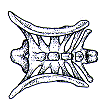 Diplodocus 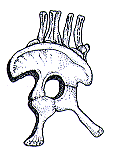 | 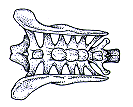 Apatosaurus 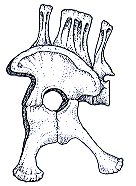 | 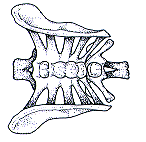 Seismosaurus 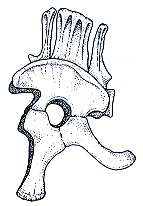 |
Comparison of the hip regions of Diplodocus, Apatosaurus, and Seismosaurus. (Drawn roughly to same scale.) Upper drawings show the hip regions from the top, lower drawings from the side. The open, nearly circular hole in each is the socket for the head of the femur. In all three genera, five vertebrae are fused in succession to form the sacrum; their lateral projections (technically, modified ribs) expand laterally to unite with the large upper bone of the hips, the ilium. The pubis projects downward and forward (to the left in this orientation), and the ischium downward and rearward (to the right). Note the tall vertical spines of Seismosaurus, and the distinct shape of the pelvic bones.
How does Seismosaurus compare with the supergiants of Dry Mesa? Our Ojito excavation produced far better data for understanding Seismosaurus than did the excavation at Dry Mesa for understanding Supersaurus, Ultrasaurus, and Dystylosaurus. In the case of Sam, the vertebral column from the base of the neck to the middle of the tail was in continuous articulation except for an interruption in the tail. The skeleton also included several chevrons, a complete sacrum with all five vertebrae and five of the six bones of the pelvis (left ilium, right ilium, right pubis, left ischium, and right ischium) in articulation, three or four isolated neck bones, and some other isolated and unidentified bones. The dorsal vertebrae had ribs variously attached, some still in living position and others slightly displaced. In addition, found around Sam's skeleton were more than 240 documented stomach stones or gastroliths in the quarry, some in contact with ribs and vertebrae. This articulated, partial skeleton is the type specimen of Seismosaurus hallorum.
Because the bones were all still connected (articulated) or only slightly displaced, we can be sure we are dealing with only one individual (and only one species), without mixture of bones from different animals or different species. With only one individual dinosaur at the site, interpretations are decidedly less complicated than from the scattered bones of dozens of dinosaurs in the Dry Mesa quarry. Undistorted, uncrushed, and devoid of dark minerals filling pore space as in most fossil bones, the perfectly preserved three-dimensional nature of the Seismosaurus bones eliminates the need to restore them for study, further reducing the hazards of conjecture.
Beginning with the weekend excavation in 1985, the anatomy of the bones of the tail clearly distinguished this skeleton from Apatosaurus, Barosaurus, Brachiosaurus, Camarasaurus, and Haplocanthosaurus, leaving only Diplodocus, Ultrasaurus, and Supersaurus as possible candidates. The tall spines on the tail bones and their extraordinary length fit the diagnosis for the Family Diplodocidae, thus eliminating Ultrasaurus (Brachiosauridae) from consideration. That left only Supersaurus and Diplodocus, two members of Diplodocidae, as candidates.
Because no shoulder bones have been found at the Seismosaurus site we cannot make a direct comparison with the scapula of Supersaurus (the only bone confidently known for that genus). Among the hundreds of bones excavated from the Dry Mesa quarry--the type locality and only known site for Supersaurus--none of the tail bones resemble the ones from New Mexico. One set of tail vertebrae from Dry Mesa that Jim Jensen assigned tentatively to Supersaurus, probably correctly, included eight in articulation from the middle of the tail of a large sauropod. They do not match the Seismosaurus tail bones, even allowing for variation, nor do any others from Dry Mesa. In addition, none of the other bones of the Seismosaurus skeleton resemble any of the bones from the Dry Mesa quarry. Overall, we can be sure that we are dealing with apples and oranges.
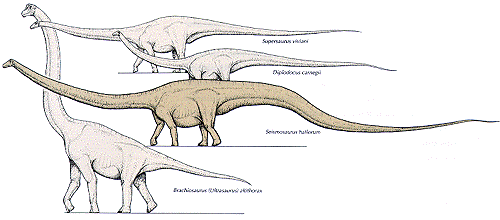
At 120-150 feet Seismosaurus was the longest dinosaur. Diploducus, Supersaurus, Brachiosaurus, and its close relative Ultrasaurus approached lengths of 100 feet. The three supergiant sauropods--Seismosaurus, Brachiosaurus, and Supersaurus--weighed almost 100 tons (200,000 pounds), or the combined weight of fifteen large elephants. Diplodocus was smaller at 15-20 tons. Some paleontologists have argued that the weights of all four of these Jurassic giants were half these figures. In their estimation Seismosaurus, Brachiosaurus, and Supersaurus weighed 40-50 tons and Diplodocus 8-10 tons.
In life, the profile of Seismosaurus sloped gently downward in both directions from the tallest point at the hips. The huge bones of the hips and sacrum indicate an enormously heavy body, probably supported on legs no taller than those of Diplodocus. The extraordinary tail, perhaps 70 feet in length, had a peculiar kink about one-fifth of that distance from the hips, probably to lower the center of gravity. The general proportions suggest a neck of spectacular length, too, maybe as long as 65 or 70 feet. These figures, in my view, establish Seismosaurus as the longest sauropod dinosaur, with a projected length of at least 150 feet. Touching tail tips at the 50-yard line, two Seismosaurus adults could rest their heads on the cross bars of the goal posts at either end of a football field. (See Gillette 1991 for the full data and calculations.)
The excavated sacrum and hip bones of Seismosaurus, which had to bear the bulk of its mass during locomotion, hint at record weight as well. The larger the sacrum and pelvic bones, the heavier the individual. In at least one dimension, the 5-foot height of the sacral vertebrae (measured from the bottom edge of the vertebra to the tip of the spine), Seismosaurus hallorum exceeds the corresponding dimensions in all other sauropods. This dimension in Seismosaurus nearly doubles the height of the corresponding vertebra in Diplodocus and Apatosaurus among the dinosaurs in its own family (Diplodocidae), and probably exceeds the height of the giant (but crushed and distorted) sacrum from the Dry Mesa quarry identified as Supersaurus.
Because Sam's pelvic bones were enormous, I have concluded that Seismosaurus was heavy-bodied like Apatosaurus rather than slight like Diplodocus. Anatomically, Seismosaurus more closely resembles Diplodocus (for example, the concave ventral surface of the caudal vertebrae and the long, slender neural spines of the caudal and sacral vertebrae), but the proportions are closer to those of Apatosaurus. Thus, Seismosaurus was most closely related to Diplodocus, but because of its heavy proportions it outwardly resembled Apatosaurus.
Sam's vertebrae are all at least 20 percent longer than the corresponding vertebrae of Diplodocus (for which the figure of 87 feet is generally accepted). This translates into an estimate of overall length of at least 110 feet. That figure assumes direct proportionality with Diplodocus, or more technically, isometric proportions. Other dimensions of Sam's vertebrae and hips do not fit isometric proportionality. For example, the height dimensions of the caudal vertebrae and sacral vertebrae range to almost double the corresponding dimensions in Diplodocus and other members of the family. Quite surprisingly, the dimensions of the lower bones of the pelvis (ischium and pubis) are markedly disproportionate: anterior-posterior lengths almost double those of Diplodocus and Apatosaurus, but the heights are roughly the same. Thus, we cannot assume isometric proportions for Seismosaurus. Instead, Sam's dimensions are nonisometric, more technically allometric : growth of different parts of Sam's body proceeded at different rates of increase.
Sam was probably no taller than Diplodocus. This assertion should be no great surprise, since the taller a quadrupedal animal, the higher the center of gravity and the less secure its stability in locomotion. But the tall vertebrae and the massive pelvic bones indicate extraordinary length far beyond what we would conclude from isometric calculations. The neural spines supported the lifting muscles of the tail, with the sacrum as the anchor. Functionally the design resembles a suspension bridge, with the sacrum as the main pillar. The taller the neural spines, the longer the tail, and correspondingly, the longer the neck. Just how much longer is hard to determine, but certainly longer than the 20 percent longer calculated by assuming isometric proportions.
Similarly, the lower bones of the pelvis contributed to control of the muscles of locomotion, especially the lateral movements of the tail (the ischium) and of the abdomen (the pubis) which in turn provided the principal anchor for the neck. The enormity of the bones of the pelvis indicates neck and tail length markedly disproportionate. According to my calculations, Sam was between 128 and 170 feet in total length; 150 feet is a reasonable estimate. It is unlikely that the one fossil skeleton of Seismosaurus that has been discovered represents the biggest individual that ever lived. Other individuals of Seismosaurus were surely longer; thus a length of 170 feet may have been reached by some members of this genus.
Whether Supersaurus or other supergiants reached similar lengths cannot be established with the current state of knowledge of sauropods, but I regard that possibility as likely. At present, however, the better-documented Seismosaurus seems to be a serious challenger to Brachiosaurus for recognition as "the largest dinosaur."
Sam's mass is much more difficult than length to determine. Because of their weight-bearing function, legs and hips are the best indicators of mass in dinosaurs. Sam's legs are missing, so we must rely on the hips. Although the ilium and sacral vertebrae will take several more years to fully extricate from their surrounding rock, we have preliminary measurements that permit comparison with other dinosaurs. Sam's sacrum is at least as massive as the large sacrum attributed to Supersaurus at Dry Mesa. That sacrum and Sam's both exceed in all dimensions the sacrum of both Diplodocus and Apatosaurus, Sam's closest relatives. Similarly, Sam's sacrum is at least as large as the sacrum of Brachiosaurus. Thus, Sam weighed as much as the other well-known supergiant sauropods, easily 100 tons and possibly more.
Overall, the questions Who was the longest? or Who was the biggest? may be fundamentally unanswerable for organisms that can be known only by their fossils. In a biological sense, Brachiosaurus and Seismosaurus, and nominally Ultrasaurus, Supersaurus, and Dystylosaurus, should all be regarded simply as giants or supergiants, or even as "the largest giants" or "the largest supergiants" because the largest individuals in all of these genera may never be discovered.